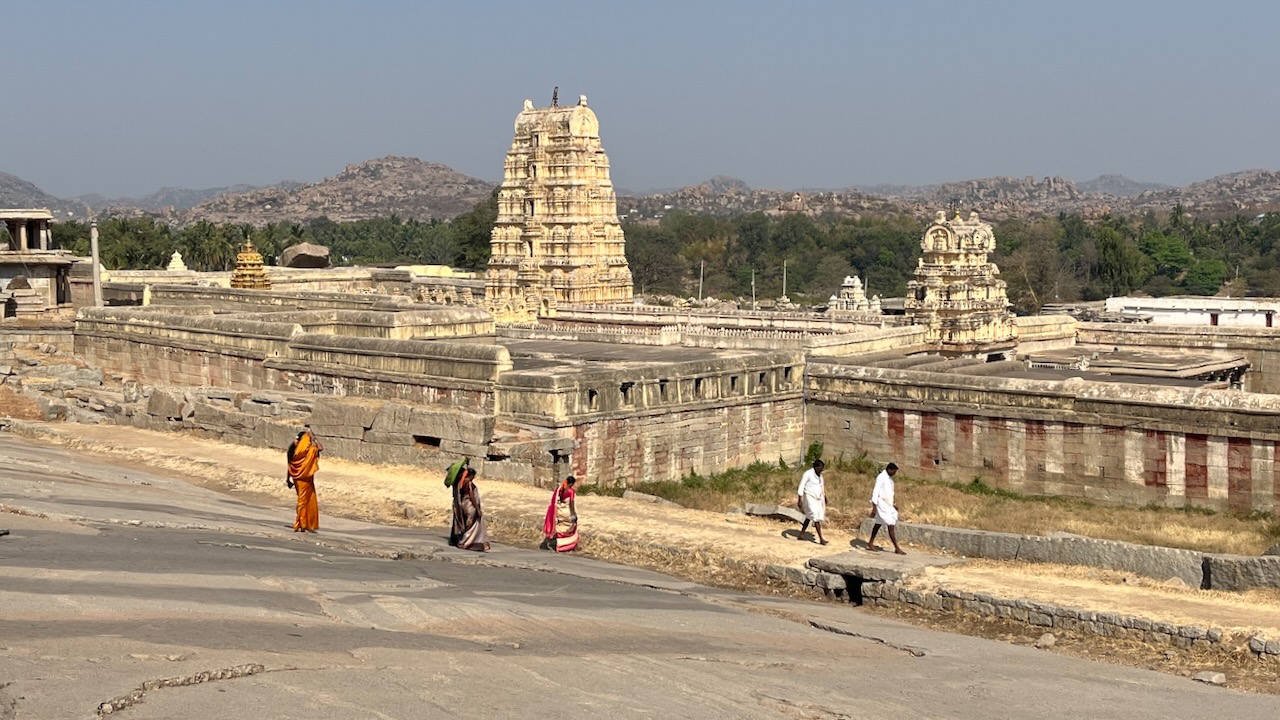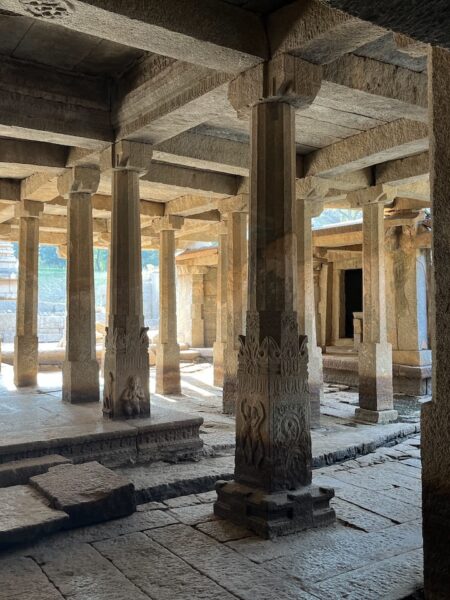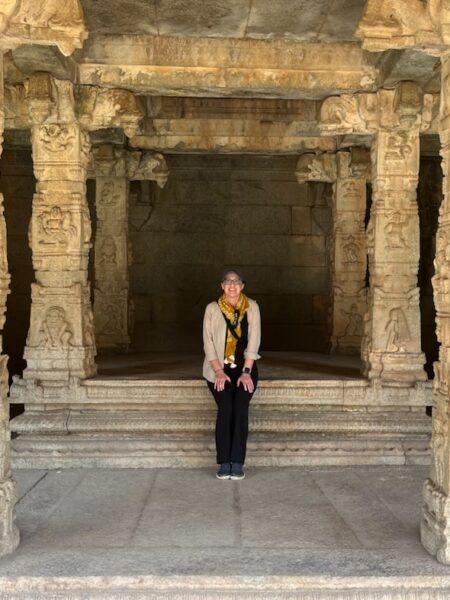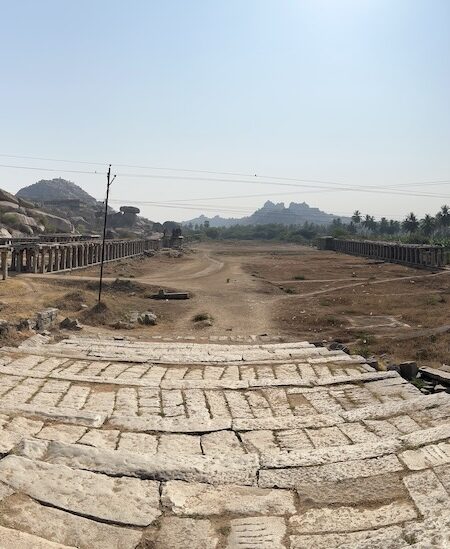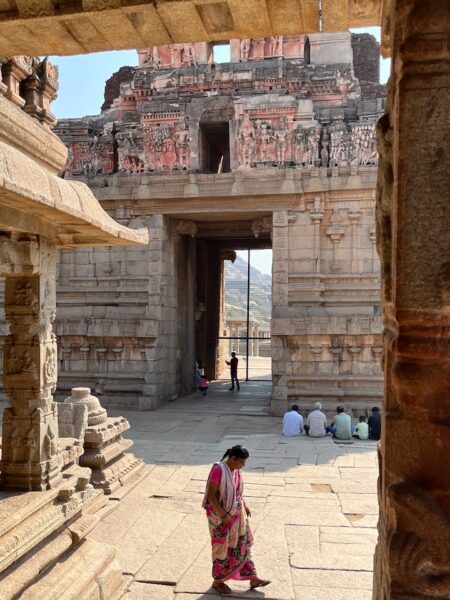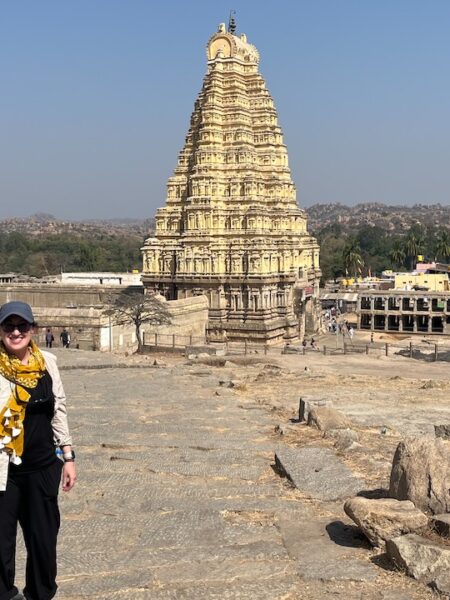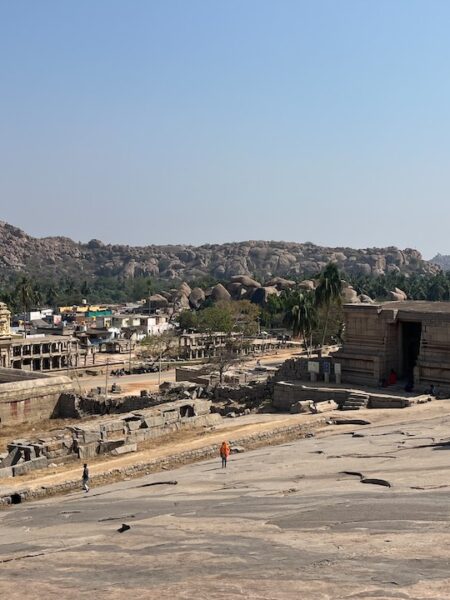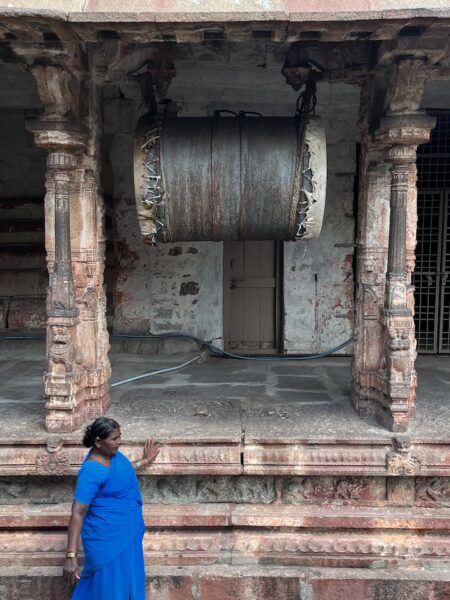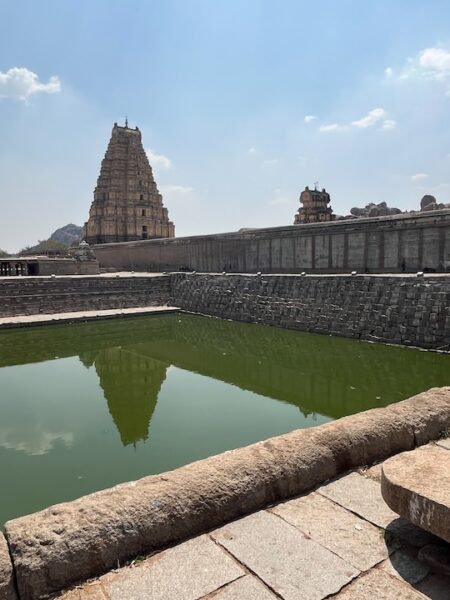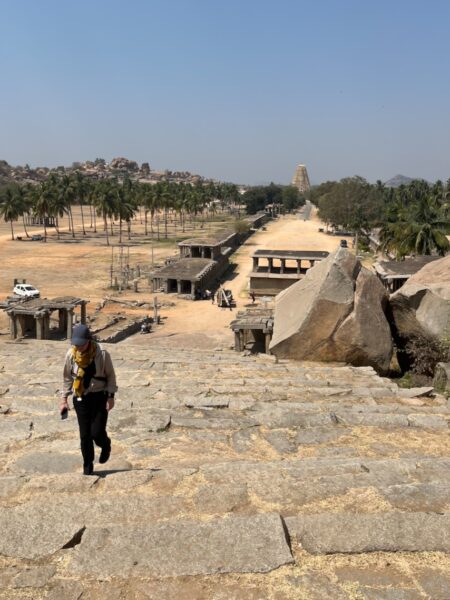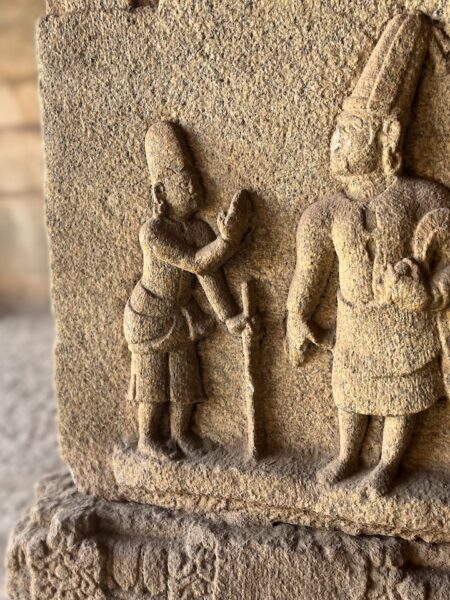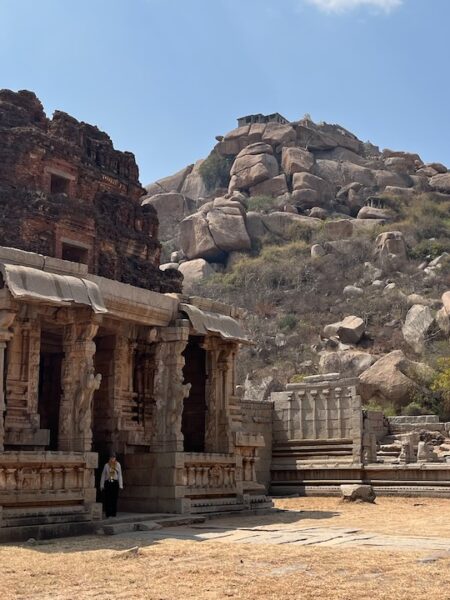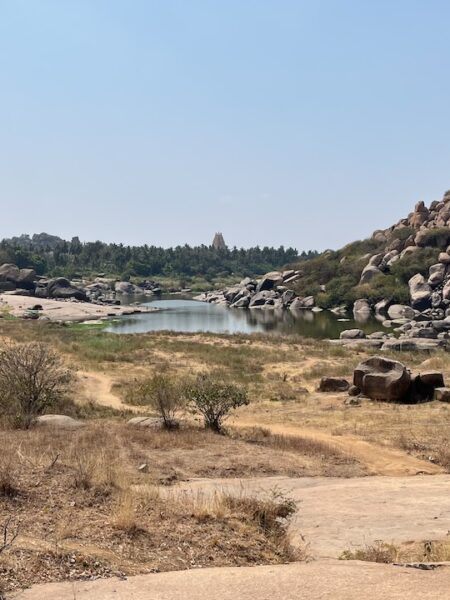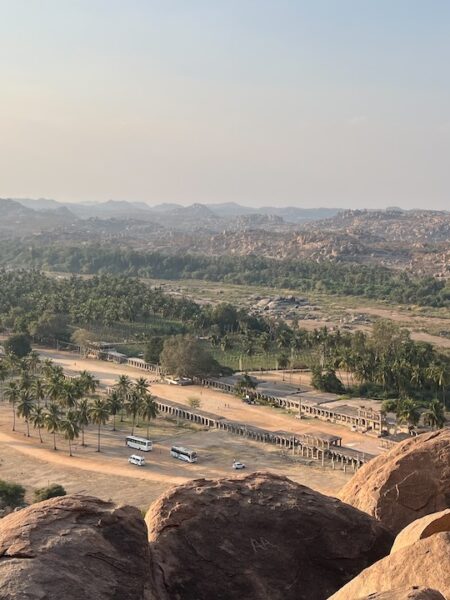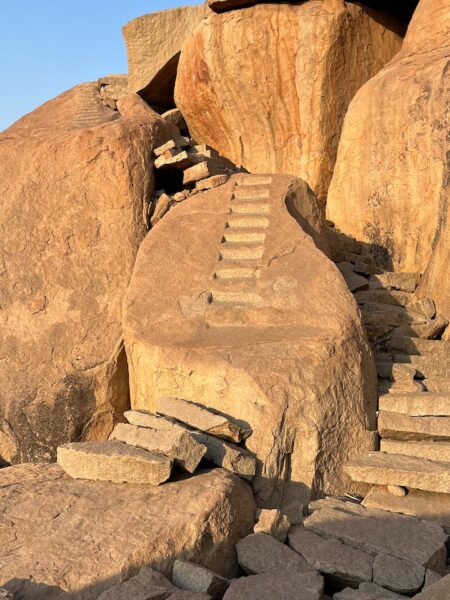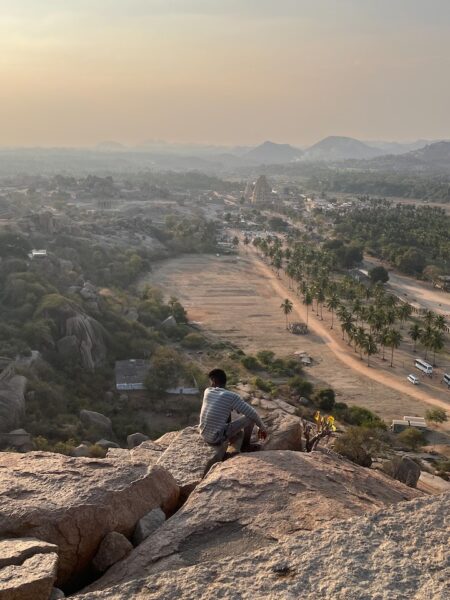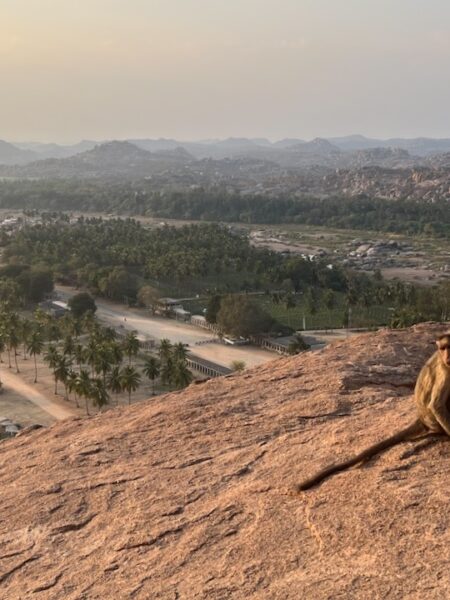My stomach is fine, if pretty gassy and slightly crampy, but I’m not sleeping well and I’m suffering from restless legs, exacerbated by hot nights lying on a rock-hard bed with one light sheet under a ceiling fan. And I seem to be dreaming much more than normal when I finally do drift off.
After another coffee and omelette breakfast we headed off with our friendly driver (Raju, though I’m guessing this is a nickname), first stopping back in the Royal Centre at the Underground Temple (so called because it was buried when first discovered, and sits below the water table). This was very atmospheric – I even had the classic moment when I shined my torch into the inner sanctuary, saw something small and twitching hanging from the further wall, then slowly panned my light up to see the ceiling covers with stirring bats! Whoops, back out slowly Peter …
Then Raju drove us up towards Hampi village. Well, it used to be a village, but about ten years ago the government suddenly cleared everyone out as part of their bid to get UNESCO World Heritage status for the site (this against UNESCO rules, I might add), and ‘museumified’ the whole area. What was once a thriving area of traveller accommodation, shops and businesses is now a barren street with the ruined colonnades on either side; a few stalls survive nearby, and the government is locked in in lawsuits with the owners of some larger ugly concrete buildings. But before reaching this area we stopped at a somewhat over-restored space that featured a small temple building housing a giant linga, next to which was a giant statue of a bestial-looking incarnation of Vishnu. I can see why there was an uproar when this ‘restoration’ was done; in fact any efforts at restoration I’ve seen have been heavy-handed, unfortunately.
Temples and colonnades were scattered everywhere as we were driven in our tuk-tuk to a huge Krishna temple. Across the dirt road from this, a wide set of stone steps swept down to a vast dirt street – or what was once a street – with crumbling colonnades on either side. I had no concept of how extensive the ruins of Vijayanagara were; it’s like visiting Pompeii, or Ephesus – I can’t imagine how spectacular the city was in its heyday.
After exploring this area, which included another huge dry tank in which Carol filmed me as I pretended to be fighting an imaginary gladiatorial battle (not historically accurate I admit, but the sunken space felt like an arena), and the huge Krishna temple nearby, we moved on to where the landscape got more rocky and became the stone expanse of Hemakuta Hill. Here, at a temple featuring a 4 and a half metre high seated Ganesha, we got our first view over the Hampi village area, and the long, wide street leading up to the Virupaksha Temple. Further down the slope, next to the temple complex, was a wide sheet of rock dotted with yet more ruined temples from the pre- and early Vijanayagara period. It was stunning spot backdropped by the two tall gopuras of Virupaksha, and soundtracked by music from the temple. After some exploration we made our way down to the main complex, put aside our shoes in a small shed provided for the purpose, and entered.
After this visual and aural lead up we found the temple less impressive than we expected; despite it being in working use it was pretty run down. We moved quickly past a compound where an elephant is kept to ‘bless’ visitors. We both financially support the return of elephants to the wild and hate seeing them in captivity.
We shuffled through a small inner shrine, ignored by the priests, and explored a dark area around the back where small creepy statues sat behind locked gates in dirty niches, monkeys wandered, and everything seemed more grotty than spiritual. But what do I know, I’m a committed atheist and don’t understand religion whatever form it takes!
After seeing a large, crumbling tank to one side with a low layer of green water in it, we were leaving the complex and the music became more rhythmic, and I stated doing a few little dance moves as I walked. A group of young men passed me and I turned around to see one of them giving me the ‘up yours’ two fingered sign. At the time I thought he thought I was being disrespectful or he just hated tourists, but I later looked it up and discovered this gesture is actually a positive, friendly one in India, and not what I thought it had meant!
Raju drove us down the wide street to the other end, and we walked up ruined steps and into the wilderness to explore the huge and atmospheric 16th century Achyutaraya Temple, then along another long colonnaded dirt street (they loved these long processional streets, the Vijanayagarans) to end up in an area of rock slopes and ruins close to the Tungabhadra River. There we found a wonderful spot high up on the slope and sat on the ruined gateway to the Narasimha Temple, and enjoyed a gorgeous view of the valley, with the gopuras of Virupaksha rearing up over distant banana trees like something out of a fantasy movie.
A hot walk back along the river to our tuk tuk, and we returned to the Mango Tree Restaurant for a relaxing lunch. Afterwards I got more rupees from a very dodgy looking ATM with its wires exposed, and we returned to our room to rest a few hours (and for me to be beaten in another game of Archaeology).
At 5pm Raju took us back to Hampi village, and dropped us off near where the steps led off to Achyutaraya Temple to start a walk up Matanga Hill to view the sunset. The steps were big broken granite ones, in some places cut directly into the granite of the hill. At one point, where the cut steps angled a bit towards the slope of the boulder, and a slip would mean a long fall probably resulting in certain death, Carol decided not to go further. I went up higher to a flat viewing area, then around another dangerous area where a sloping ledge led around another huge boulder and one slip etc etc … Beyond that the path led up to a relatively recent temple, but I stopped and returned to Carol, where she’d found a good place to sit and watch the sunset. We met and chatted with some slightly older English tourists, two of whom had spent their childhood in southern India. The monkeys were bold and jumped up on one of them before she shooshed it away. The view over the Virupaksha and Krishna temples and swathes of green palm leaves was spectacular, a big red sun descending into the thick line of haze at the horizon.
Another good dinner at the restaurant, and back to our room before 8.30pm. Another amazing day!

